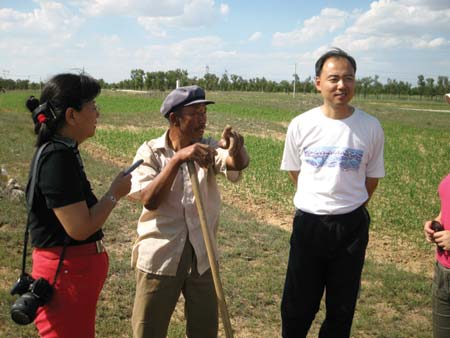For green rivers and the blue sky
 |
|
Ma Jun (right) talking with a local farmer during a field trip to polluted areas carried out for the production of his environment maps. |
Environmental protection does not necessarily entail grand responsibilities. For the general public, a green mind in everyday life is a more important asset. And for Ma Jun, director of the Beijing Institute of Public and Environmental Affairs, his awareness of everyday life, or more precisely, his collection of environmental information, helped him to succeed in producing two important environmental maps: the China Water Pollution and Air Pollution maps.
|
All in this series: |
The experience of developed countries shows that the ultimate breakthrough in resolving environmental problems lies in extensive public participation in environmental issues, and Ma understands the importance of this. In effect, these two environment maps are Ma's major achievements, alongside his China Water Crisis, a book published in 1999 which elaborated on issues such as flood, drought, water shortage, and pollution issues on the country's main waterways. The success of the maps has provided an excellent platform and served as a guiding compass for broader and more concentrated public participation.
The so-called maps are in fact public databases of China's water pollution and air pollution conditions. Rudimentary as it is, such work has groundbreaking value for a society lacking in digital management.
The Beijing Institute of Public and Environmental Affairs opened in June 2006. Four months later, Ma released China's first public database of water pollution – the China Water Pollution Map. According to Ma, he produced these maps because he wanted the public to get timely information on the water quality, pollutant emissions, and pollution sources of the areas where they live, and the degree of contamination in different regions of China. "How can the public participate if they have no idea what is happening to their drinking water, no idea of the state of their water environment, no information on how businesses are illegally discharging waste? The e-map assists them with direct information feed."
The water pollution map collects data from such state administrative departments as environmental protection, water resources, maritime administration, territorial resources, fishing and others, providing information on water quality, pollutant discharge, pollution sources, businesses that exceed discharge quotas, and sewage treatment plants from about 300 prefecture-level cities in 31 administrative regions at the province level. It has exposed close to 10,000 high-polluting enterprises, including 270 multinationals with a reputation for their commitment to the protection of the environment.
Anyone who cares for China's environment can check out the map.
 0
0 






